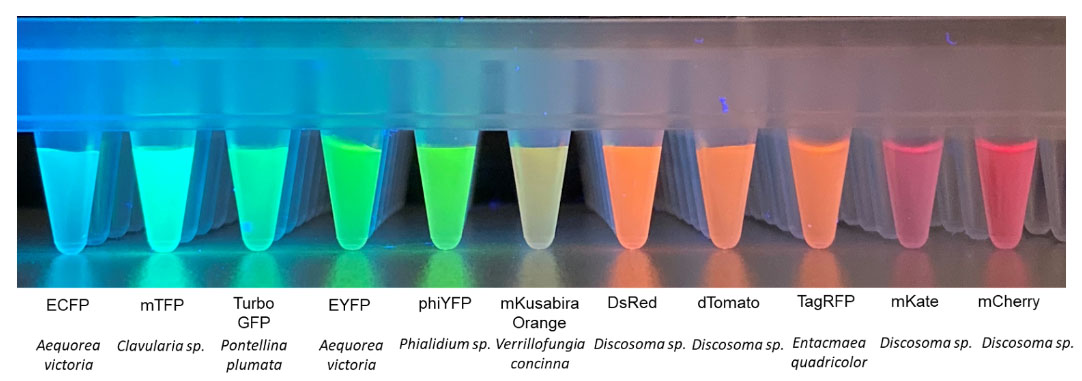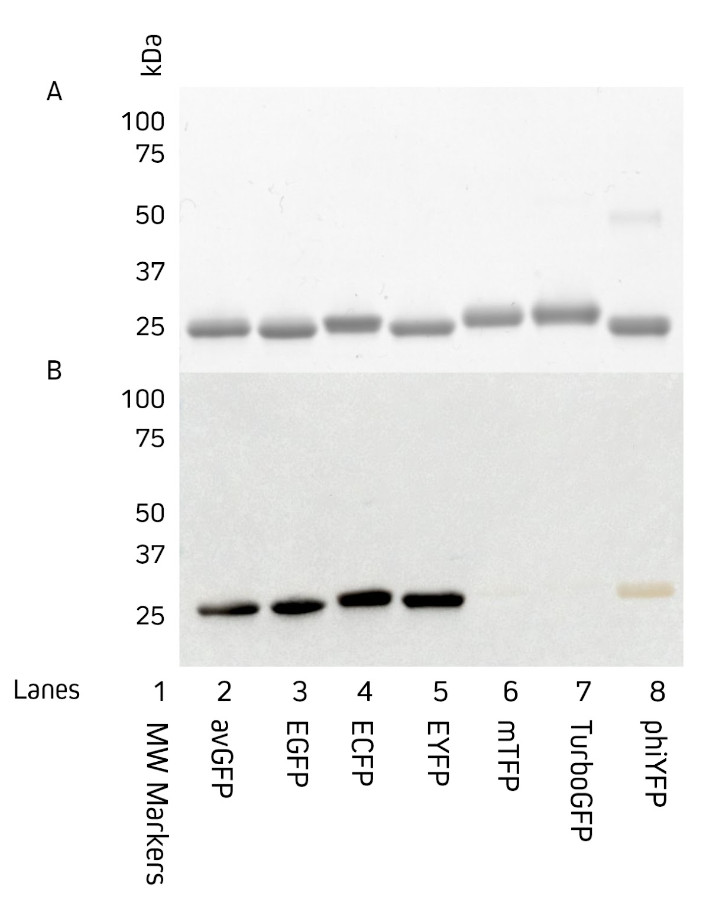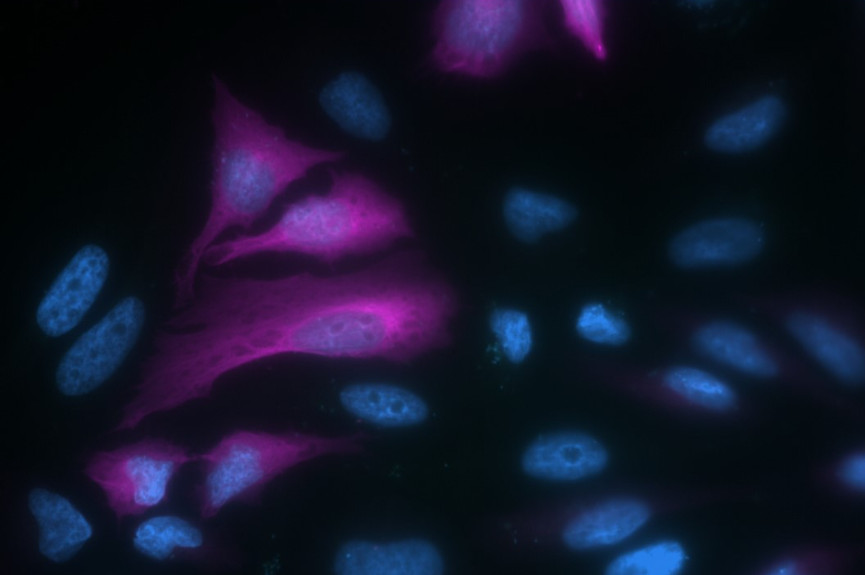
"I have used a wide variety of secondaries and Jackson ImmunoResearch has consistently been the best. The fluorophores are bright and stable and their selective (x reactivity removed) secondaries have always shown species specificity in multiple labeling."
Janet Duerr, Ohio UniversityRating: 5.0
Green fluorescent protein (GFP) was isolated from the bioluminescent jellyfish Aequorea victoria by Osamu Shimomura in 1962. It wasn't until 1994 that Martin Chalfie first applied it to monitor gene expression. The utility of GFP as a tool soon became apparent, and a raft of other useful fluorescent proteins in a rainbow of colors were isolated and developed. The value of GFP was later recognized in the 2008 Nobel Prize. Fluorescent proteins are invaluable in many aspects of life science. For example, their fusions/chimeras enable the detection and quantification of protein/gene expression and the characterization of molecular interactions. Jackson ImmunoResearch now offers polyclonal Rabbit Anti-GFP antibody conjugates for the detection of GFP and its derivatives across a range of applications.

GFP is a common protein tag that can be used to generate fusion proteins in a variety of prokaryotic and eukaryotic systems. It can be expressed either transiently or constitutively depending on the researcher's goal. This tag is useful as a reporter molecule because it does not require exogenous substrates or cofactors to generate fluorescence (citation). GFP is employed in numerous applications including quantification of gene expression, protein localization within a living organism, studying protein interactions, and as a biosensor.

Developed by the laboratories of Thastrup and Falkow in the late nineties, enhanced GFP (EGFP) possesses a single point mutation (F64L) that improves the brightness and subsequent tractability of the molecule. EGFP is the most prevalent variant of GFP used in molecular biology currently. Other variants of the initial GFP have subsequently been developed that have different spectral characteristics, giving rise to yellow and blue (cyan) fluorescent proteins.
After Shimomura's discovery of GFP, scientists began to investigate the properties of fluorescent proteins from other organisms. These genetically encoded fluorescent reporters were also subject to modification to alter their spectral characteristics so that they would excite and emit at different wavelengths, as seen in Fig 1.
Anti-GFP antibodies allow the detection of the GFP protein when direct fluorescence detection is not possible. Examples include autofluorescence in the GFP channel, when another reporter molecule is required (Western blotting), or when the fluorescence of the native GFP is compromised or not sufficient and needs to be amplified.
Jackson ImmunoResearch AffiniPure® Rabbit Anti-GFP is an affinity-purified polyclonal antibody raised in rabbit and can be used to detect Aequorea victoria Green Fluorescent Protein (avGFP) and its derivatives, including EGFP, ECFP, and EYFP (Fig 2).

An Anti-GFP antibody can be used to amplify the signal from GFP expressed by cells in IHC or IF experiments. Anti-GFP may also be used in immunoprecipitation/protein pulldown assays. Our rabbit polyclonal Anti-GFP antibody may be used in ELISA, IHC, ICC, IP, Flow cytometry, and WB.
Jackson ImmunoResearch Anti-GFP antibody is available conjugated to a range of reporter molecules. Image with fluorescence microscopy using JIR's comprehensive selection of Alexa Fluor® dye conjugates. These conjugates combined with the polyclonal format of JIR Anti-GFP antibodies deliver bright target signal and spectacular signal amplification.
Anti-GFP antibody conjugates can add versatility to an assay when trying to work around autofluorescence or equipment limitations, such as when a laser line or channel is occupied by another target. Using a fluorophore that emits in another channel, Anti-GFP antibodies can circumvent these limitations - making them useful when detecting multiple targets in the same experiment.

| Conjugate | Excitation Peak (nm) | Emission Peak (nm) |
|---|---|---|
| Alexa Fluor® 488 | 493 | 519 |
| Alexa Fluor® 555 | 552 | 572 |
| R-Phycoerythrin, R-PE | many, 488 | 580 |
| Alexa Fluor® 568 | 577 | 602 |
| Alexa Fluor® 594 | 591 | 614 |
| Alexa Fluor® 647 | 651 | 667 |
| Alexa Fluor® 680 | 684 | 702 |
| Alexa Fluor® 790 | 792 | 803 |
Anti-GFP conjugates also include popular reporter enzymes, Horseradish peroxidase (HRP), and Alkaline phosphatase, as well as a biotin conjugate facilitating the use of chromogenic IHC staining techniques and amplification protocols such as ABC (Avidin-Biotin-Complex) and LSAB (Labeled streptavidin-biotin). Switching to a non-fluorescent detection system enables the use of traditional light-microscopy techniques such as chromogenic IHC.
| Product Description | Product Code | |
|---|---|---|
| Peroxidase AffiniPure® Rabbit Anti-GFP | 300-035-245 | |
| Alkaline Phosphatase AffiniPure® Rabbit Anti-GFP | 300-055-245 | |
| Biotin-SP (long spacer) AffiniPure® Rabbit Anti-GFP | 300-065-245 |
Western Blot and ELISA (Enzyme-linked immunosorbent assays) can be used to both confirm and quantitate the expression of proteins. GFP is a popular reporter molecule used to identify successful protein expression in the absence of protein-specific antibodies. Read our article exploring the use of JIR Anti-GFP antibodies to assess protein expression qualitatively and quantitatively.
Flow cytometry is a useful technique for screening and quantifying expression, particularly when proteins are expressed on the surface of a cell. The GFP tag is frequently used as a reporter molecule to track protein expression by flow cytometry. Learn how Jackson ImmunoResearch AffiniPure® Rabbit Anti-GFP can be used to detect a GFP fusion protein expressed on yeast cells by flow cytometry.
Table 2: Anti-GFP antibody conjugates